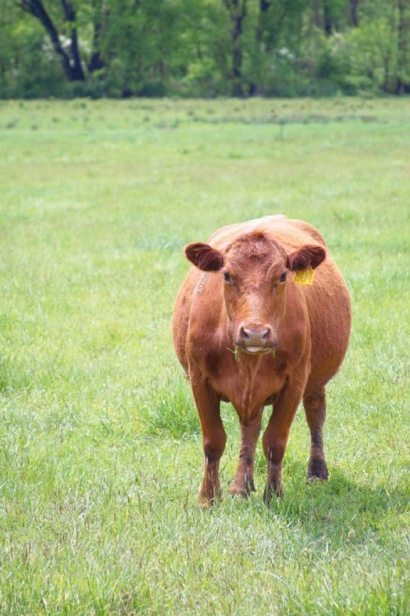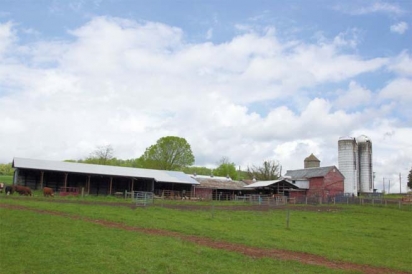Tullamore Goes Against The Grain
A woman farmer makes the leap into raising grass-fed beef
The first time I met Jeanmarie Mitchell at her farm, Tullamore, in Stockton, winter was late in coming and the pastures were still a verdant green. Mitchell had planted rye grass in October so her beef cows could graze all winter. By the looks of the cows chowing down on the grass, they couldn’t have been happier with her choice.
“They love grazing in the fresh air and warmth of the sun,” Mitchell says. “But they always have choices.” Though every day a fresh area of the pasture is opened for them, there’s also a path back to the barn. It’s an open lean-to with access to fresh water and a mix of nutritional hays she grows for them, including timothy, wheat, oat, orchard and alfalfa. “They’re great fun to watch,” she says. “And they’re very good at telling me what they want.”
Farming—let alone raising grass-fed beef—was never part of Mitchell’s childhood in upstate New York. But when she first saw this historic 208-acre farm 13 years ago, she fell in love with it and knew that’s where she belonged. Married at the time, she purchased the farm with her then husband. Figuring out what she wanted to do with it came later. At first she continued the previous owners’ horseboarding business and rented part of her land to a hay farmer. But she didn’t like his use of chemicals. This prompted her to learn about growing hay and then to buy secondhand haying equipment to start a business of her own.
A fellow farmer, Jim Lyons of Blue Moon Acres, recommended Michael Pollan’s book The Omnivore’s Dilemma. It turned Mitchell around. She started looking into grass-based farming and, in February 2009, attended her first Pennsylvania Association for Sustainable Agriculture (PASA) conference. Not long after, Greg Zdepski, a neighbor who had an animal biotech degree, started helping her part time. She gave him a copy of Pollan’s book and said they were going on a field trip to Polyface, Inc., the farm owned by Joel Salatin, a leader in pasturebased meat and poultry farming. Mitchell had paid for a private tour. “On the car ride down I told Greg I was going to raise grass-fed beef. He must have thought I was crazy,” Mitchell recalls.
The trip clinched her commitment. A few months later she bought 15 cows. (She now has 50, a mix of Black Angus, Red Angus and Hereford.) Before the cows’ arrival in October 2009, Mitchell adapted some of the ideas she had learned from Salatin to fit her vision of raising 100 percent grass-fed beef using humane and sustainable practices. “Corn,” she says, “is just carbohydrate fluff for the cows, like eating Twinkies.” According to recent studies, including a 2010 study published in the Nutrition Journal and a 2009 joint study by the USDA and researchers at Clemson University, there are at many good reasons to choose grass-fed beef over corn-fed. Because the cows graze on nutrition-rich grasses, their meat is lower in total fat and lower in cholesterol, calories and saturated fats linked to heart disease. Grass-fed beef is also higher in omega-3s, vitamin E, betacarotene and the B vitamins than corn-fed beef.
Using grant money from the Natural Resources Conservation Service, Mitchell and Zdepski built movable fences for rotational grazing. They were already experimenting with nutritional hays and grasses and, after a year of applying sustainable farming practices, they began seeing an increase in grass growth and soil fertility. It took another year and a half before the first cattle were ready for market. (Grass-fed cattle typically require six months to a year longer to raise to market weight than commercially raised grain-fed beef, which is one of the reasons grass-fed beef costs more.) Mitchell doesn’t use a scale to weigh her cows, although it’s on her long laundry list of farm equipment she’d like to buy. “They tell me when they’re ready,” she says. “I look at the fat under their eyes, on their tails, rump and brisket. They get beautiful and fat and delicious.”
Following slaughter, which is typically done after the cattle have grazed 24 to 30 months, Mitchell’s beef is dry-aged for two weeks. She says the process creates more tender and flavorful meat by breaking down muscle fiber and reducing the water content. It’s costlier for the farmer, though, because some of the meat is lost to shrinkage as well as to the trimming of the dry outer layer.
That first summer, Mitchell’s younger daughter, Caitlin Solano, now 23, joined her on the farm. Solano added laying hens to the mix, moving them in portable coops to forage behind the cows. She’s already won a following for her fresh eggs, says her proud mother. “I talk everything over with her, and Caitlin maintains the farm’s website, produces our brochures and is the face our customers know best at the Stockton Market.” She’s also a great cook, says Mitchell. Customers at Tullamore’s Stockton Market table are regularly questioned by Solano as to the product’s use. Meatloaf or hamburgers? She’ll suggest which of their packages of ground beef to buy: lean or one with more fat content. More fat, she says, is best for grilling.
Despite owning a large farm, Mitchell was strapped financially when she started Tullamore. A bank loan was crucial to the farm’s survival. But unless they’re part of a big agribusiness, she says, farmers aren’t seen as moneymakers. Compounding the problem, she believes, was the fact that she and her daughter were two single women—and therefore were viewed as hobby farmers at best. Widening her big, blue eyes and lifting her long, red hair, she says, “The more roadblocks in my way, the more it made my Irish kick in. There had to be a loan for two single female farmers.”
Last September, after two years, Mitchell received that loan from the USDA Farm Service Agency. A month later, as if in affirmation of her vision, Tullamore Farms won PASA’s fourth annual 100% Grassfed Beef Cook Off. “A friend called me and said I had broken the grass ceiling.”
Everything Mitchell now earns is plowed back into the farm. She laughs at the long list of things she has learned to do: drive a tractor, breed bulls with her cows, birth calves, and even dig a trench for a 1,200-foot water pipe (last December, with Zdepski and a friend). “From where we started to where we are now, it seems so simple—so magical. But we know it’s not. It’s a lot of hard work caring for the cows, figuring out solutions to problems.”
Along with selling at the Stockton Market on weekends, Mitchell now sells to local chefs Brian Held of Brian’s in Lambertville and Matt Ridgway of the charcuterie PorcSalt and The Pass restaurant in Rosemont. Before meeting with Held, Mitchell studied the North American Meat Processors Association handbook, The Meat Buyer’s Guide, to learn the restaurant lingo. “When he asked for a 1114D,” Mitchell says, “I knew he meant a flatiron steak.” For Ridgway, she’ll be raising heritage cross pigs.
Lilly’s Meals in Stockton, the Vincentown Diner in Vincentown and Escape in Montclair use Mitchell’s beef for their hamburgers. And Blue Moon Acres carries her beef in its Pennington market. Future plans for Mitchell include converting the milk house on the property to an on-site market, offering farm-to-table dinners and getting involved in agritourism.
Mitchell admits to worrying about failing. Then, lowering her voice, she says, “If you tried your hardest, how did you fail? If you pave the way for others, how did you fail?”
Some days, she says, she wakes up and asks herself why she continues. “Then I see my customers and I know them. I see my animals. I know I’m giving them a better life than they would have had. I get to feed people pure food and take care of the land I was blessed with.”
TULLAMORE FARMS
Stockton
609.548.2569
Editor’s Note: For a list of other pasture-based beef farmers in New Jersey, see “Meat Matters” in our Winter 2012 issue.








